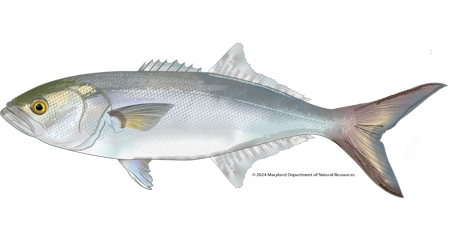| Bluefish |  |
Bluefish | | Pomatomus saltatrix | (A.K.A. - Blue, Snapper, Skipjack)
| Key Distinguishing Markings:
- Bluefish get their name from their color. The fish are a greenish blue with silvery sides and a white belly.
- Bluefish have a pointed snout and large mouth.
- The lower jaw of a bluefish sticks out past the upper jaw.
- Bluefish have a sturdy compressed body, a large head, and pointed, razor sharp triangular teeth.
- Note the black blotch at base of pectoral fin.
- Bluefish are the only members of the family, Pomatomidae, and are closely related to jacks, pompanos, and roosterfish.
View the Bluefish Gallery
| Distribution:
- Bluefish are found throughout the world and are a migratory species that range from Nova Scotia to Florida off the Atlantic coast and can be found in the Gulf of Mexico from Florida to Texas.
- Along the east coast, bluefish migrate northward in the spring and summer and southward in the fall and winter.
- During the summer, bluefish are concentrated from Maine to Cape Hatteras, North Carolina and during the winter, most tend to be offshore and south between Cape Hatteras and Florida.
| Size:
- Bluefish can live to be 12 years old and can reach 40 inches in length.
- Bluefish in the Chesapeake Bay, however, average about 12 inches in length.
| Habitat:
- There are bluefish in all the world's oceans.
- They can be found throughout the Chesapeake Bay, its tributaries and in the Atlantic Ocean and coastal bays.
| Spawning:
- Most juvenile bluefish spawned in the south during the summer in the mid-Atlantic and in the fall spring in the South Atlantic remain in the coastal waters, but some summer-spawned fish do enter the lower Bay for a couple of months before they return to the coast in the fall and join the adults in their move southward.
- Most bluefish mature by age 2 (approximately 14½ inches), and females can produce from 900,000 to 4,500,000 eggs.
- Spawning and larval development takes place offshore in the South Atlantic (North Carolina to Florida) in the spring and to a lesser extent in the summer and fall, and in the mid-Atlantic during the summer. In Maryland, peak spawning occurs offshore in July.
- After they spawn, bluefish move inshore with smaller fish generally entering Chesapeake and Delaware Bay and larger ones moving northward.
- Juvenile bluefish grow quickly and by late fall, there are usually two size groups along the mid-Atlantic and New England coasts.
- Those fish that were spawned in the south during the spring are 6-8 inches, whereas those spawned in the summer are 2-4 inches.
- Most juvenile bluefish spawned during the summer in the mid-Atlantic and in the spring in the South Atlantic remain in coastal waters, but some summer-spawned fish do enter the lower Bay for a couple of months before they return to the coast in the fall and join the adults in their move southward.
| Fishing Tips:
- For current recreational size and creel limits, see Maryland's updated regulation page.
- Peak abundance of bluefish near the mouth of Chesapeake Bay occurs in April-July and again in October-November.
- Bluefish are well known to anglers as an incredible fighter with tremendous biting power.
- They are a highly prized fish and the most sought-after species among recreational fishermen during May through October in Chesapeake Bay.
- In the Bay, fishermen catch bluefish by trolling, or casting artificial lures. Cut baits are good for catching bluefish.
- On the beaches near Ocean City, people surf fish for bluefish in the fall.
- Approximately 90% of the bluefish harvested in Maryland are caught by sport fishermen.
- Commercially, most Bluefish harvested in the bay are caught in pound nets, while those harvested on the coast are caught in trawls and gill nets.
- Since 1995, commercial bluefish fisheries have been managed under a coastal quota system.
| Fun Fact:
- Bluefish are a pelagic schooling species that primarily travel in groups of like-sized fish.
- Adult fish migrate like birds, traveling north in the spring and south in the fall and winter.
- Known as the "marine piranha" because of its aggressive feeding habits. Bluefish have been known to strike at anything.
- Bluefish are so voracious they will even kill prey they do not eat and have occasionally bitten human swimmers who were unfortunate enough to encounter a feeding school.
- Anglers often use wire leaders to prevent the sharp teeth of the bluefish from cutting their lines.
| | Family: Pomatomidae (Bluefishes) | | Order: Perciformes (perch-likes) | | Class: Actinopterygii (ray-finned fishes) | For information concerning bluefish and their management, please contact Eric Durell.
Illustration by Duane Raver
|
|
